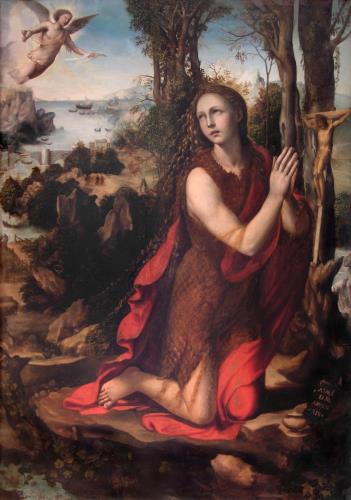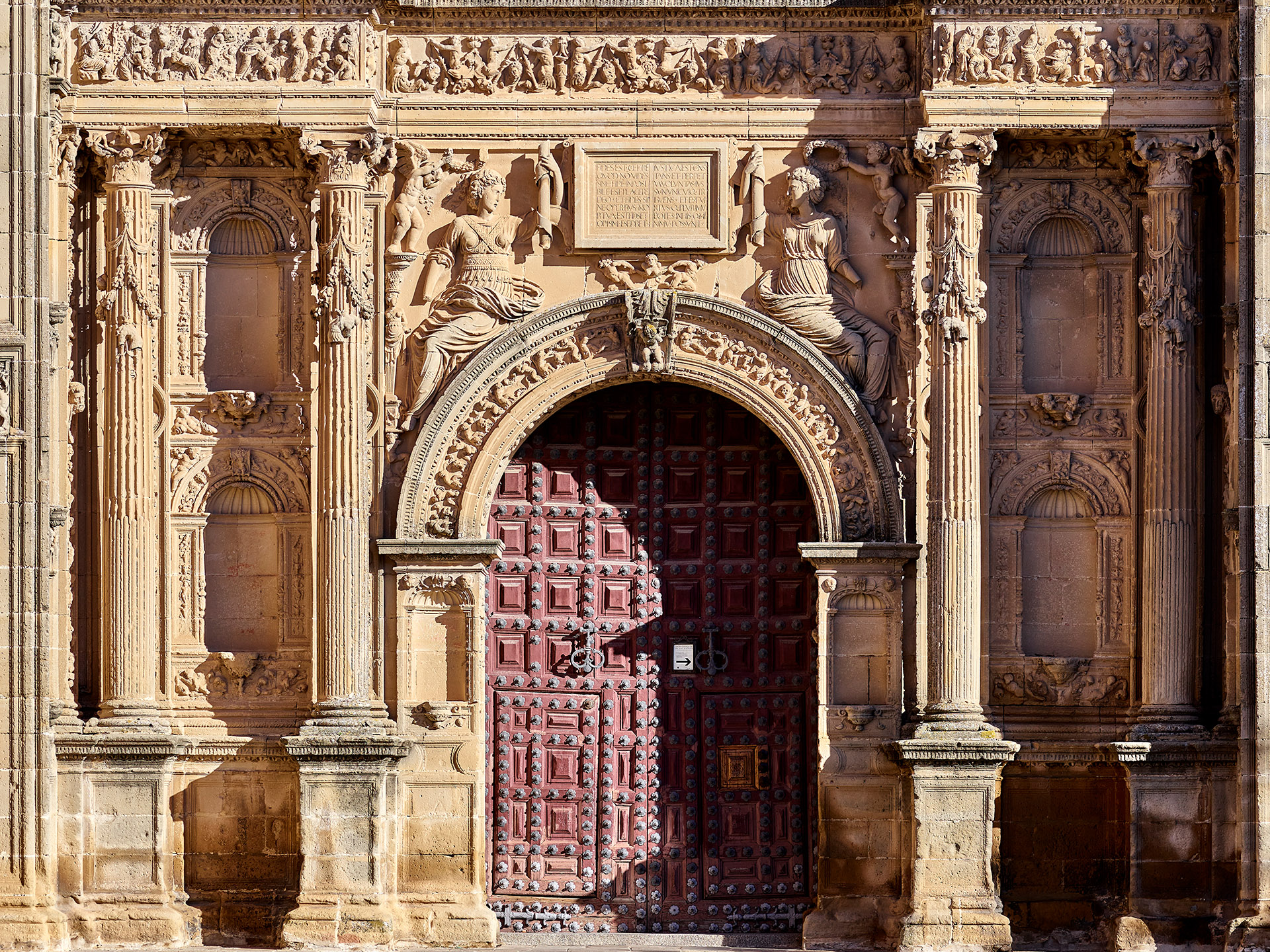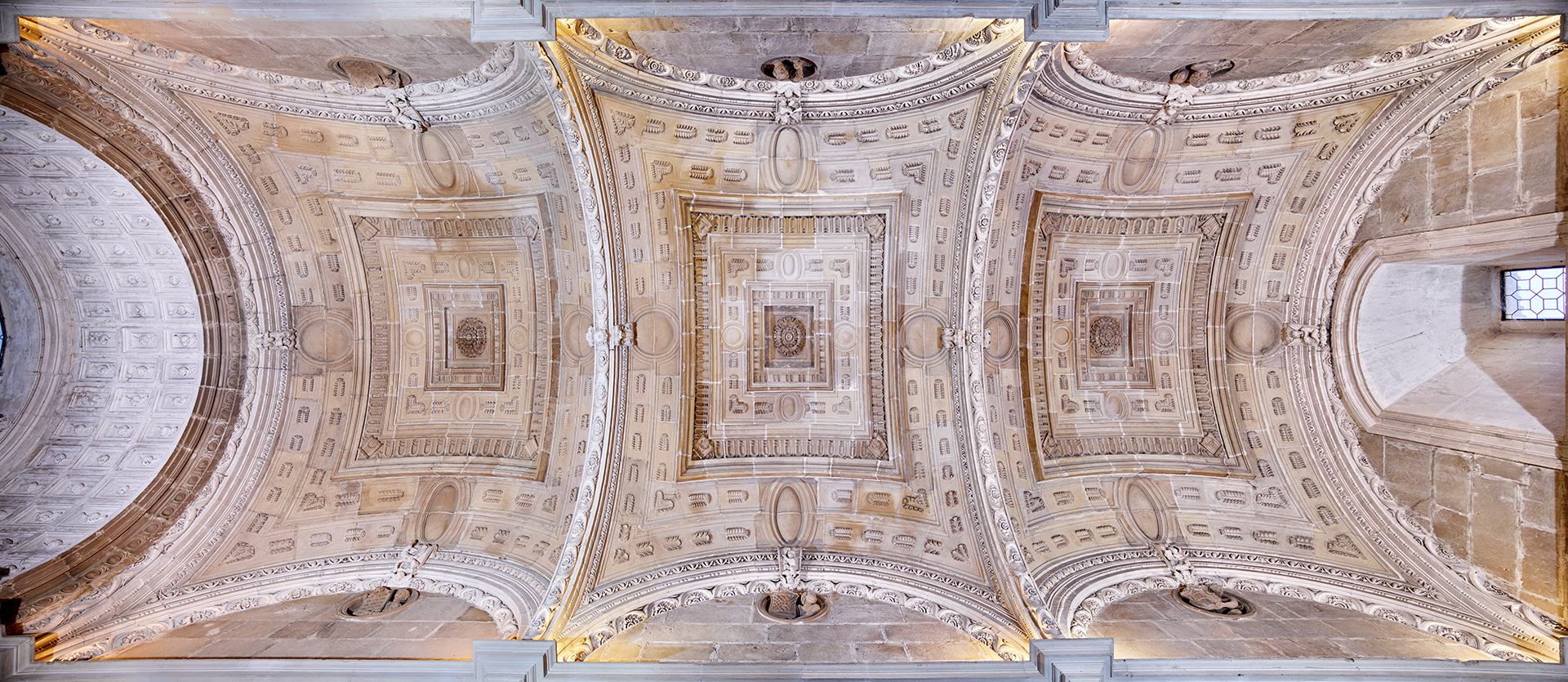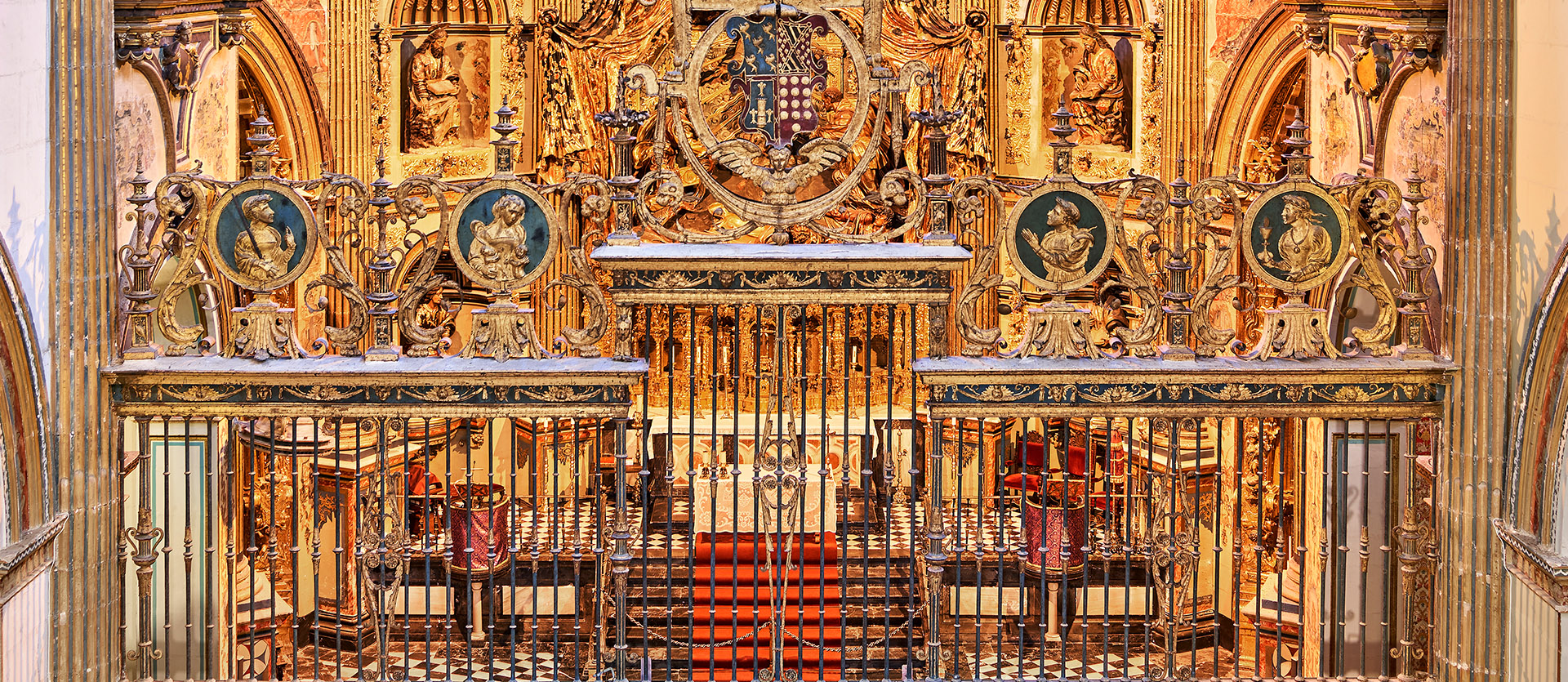History of the Chapel of the Saviour
The Chapel of El Salvador appears today as an isolated unit, but it was conceived by Francisco de los Cobos as part of a complex urban planning operation that involved the transformation of an entire block of the irregular and saturated urban grid of the Santo Tomás district. In addition to the erection of his funerary pantheon, whose façade opened onto the only free space in the city, the then Llano de Santa María and today Plaza Vázquez de Molina, it included the extension of the old paternal mansion to transform it into a large palace, the refurbishment of the Hospital de los Honrados Viejos de El Salvador and the creation of a Estudio General. This operation marked the beginning of the transformation of the urban layout of Úbeda which, as it was carried out almost entirely before the end of the 16th century and its main promoters were relatives of Francisco de los Cobos, gave it a surprising formal coherence.
Such an ambitious programme is not the result of chance, but of a patient design in which the social and political ascension of its promoter and, especially, his contact with Italian society and art play an essential role. To understand this process, we must go back to the Commendatore's first, much more modest, funerary projects. This history is divided into periods, which can be accessed by clicking on each date on the chronological axis below to mark the beginning.
The first funerary project: the chapel of La Concepción
In the mid-1520s, the funeral project promoted by the imperial secretary was a relatively modest family pantheon: a chapel under the dedication of the Immaculate Conceptionattached to the parish church of Santo TomásThe second most important in the city, very close to his father's house, of which only a few recently recovered archaeological remains survive today. Although he was still many steps away from the dazzling social ascent that we know today, at that time Francisco de los Cobos already had an important social position: through his marriage in 1522 with the young woman María de Mendoza y Sarmientodaughter of the Counts of Ribadaviahad been related to one of the most powerful lineages in Castile, the Mendoza family; he was knight of the order of Santiago; member of the Royal Council and dominated the newly created Finance Council.
In the years immediately following their marriage, he bought the land and in 1525 began the construction of the new funerary chapel for him and his parents. Located on the Gospel side, it was the largest and most splendid of all the chapels in the church of Santo Tomás. He put the project under the supervision of his right-hand man in Úbeda, Fernando Ortega Salido -better known as the deán OrtegaHe was appointed senior chaplain of the newly founded patronage, for which the pope, Clement VIIapproved in 1529 a chapter The building consisted of a senior chaplain and six chaplains, and, in order to facilitate its construction, he successively added several indulgences and benefits.
Related content

Francisco de los Cobos

Genealogical record of María de Mendoza
From father's mansion to palace

Façade of the façade of the palace of Los Cobos
It was in the first five years of the next decade that the first elements of complex design began to appear. Two deaths almost simultaneously occurred in 1530: that of the Grand Chancellor, Mercurio Gattinaraand that of his father, Diego de los CobosThe new social and cultural institutions, both in the public and private spheres, act as a symbolic caesura, which makes their extraordinary social promotion evident.
In1529, Charles V had approved the appointment of Cobos as a Commander Major of Leónfirst, and State Counsellorlater on. With his first appointment, he received the highest distinction to which a courtier of his status could aspire, as there were only two major commands of the Order of Santiago: that of Castile and that of León. The fact that the latter had previously been in the hands of Hernando de Toledo, younger brother of the Duke of Alba, gives an idea of its social relevance. The second meant entering the select group of the emperor's privy council and becoming the most powerful adviser on Castile's internal and financial policy, as well as on imperial policy and especially on matters relating to the Holy See and the Italian states. Charles V, on the death of Grand Chancellor Gattinara, decided to personally assume the direction of imperial policy and to use Granvela and Cobos as senior advisors and agents of his diplomacy. During the decade following the imperial coronation in Bologna in 1529, the Commendatore Maggiore accompanied the Emperor on all his journeys, which put him in a position to contact with Italy and with the prestige that architecture and art conferred on the great Renaissance lords.
A la death of his fatherThe first of these, which occurred during his stay in Italy, he inherited the old family homeHe was already the undisputed head of a new network of patronage and honour incomparable, in terms of wealth and power, with the local dimension of the lineage into which he had been born. This new social position was to be reflected in his hometown by means of the renewal of the lineage's signs of identity: the palace and the pantheonThe aim was still, at the same time, to identify them both with their ancestors and to proclaim the birth of a new branch that would have the Commander Major as its founder.
From the early 1930s, while Cobos travelled around Italy with the Emperor, his agents in Úbeda began to acquire houses, eleven in total, adjoining the mansion of his parents, with the aim of creating, in a particularly crowded area of Úbeda inherited from the Middle Ages, the site on which to enlarge the mansion inherited from his parents, which today is known as the "Casona". Palacio de los Cobos and perhaps he was already thinking of erecting a free-standing pantheon to perpetuate his memory, in the manner of those he was seeing in Italy.
In any case, once the site had been partially shaped, work began around 1532 on the extension of the paternal mansion to transform it into a large palace, for which he once again resorted to the Royal Architect Luis de Vega who had already worked for Cobos on the remodelling of his palace in Valladolid (later the Royal Palace and today the Captaincy General). It was a palace with a courtyard with three arcades and a rear garden with a façade with a corridor overlooking the Guadalquivir valley.
Related content

Genealogical record of Diego de los Cobos de la Tovilla
The exempt cemetery project

Plan of the Chapel of the Saviour. Gómez Moreno
As he began work on his palace, he pleaded with the pope Paul III -with whom he was negotiating the convocation of a council - to issue the corresponding bull for the erection of an new church under the patronage of El Salvador and authorising the transfer to it of the privileges, benefits and indulgences granted to the Chapel of the Conception, a chapel which, nevertheless, he also continued to build, but now dedicated solely to the burial of his parents, disassociating the new exempt temple from the memory of his predecessors.
In the meantime, to the eleven houses and plots of land that he had already acquired, in 1534, he added some land ceded by the Brotherhood of the Venerable Elders of the Divine Saviour with which the deán Ortega had reached an agreement which established, among other things, that a church was to be built there, under the name of El Salvador, whose main chapel was to be located where the altar of the existing church was and whose nave was to be the size of that of the nearby church of San Pablo.
On 2 February 1535, Paul III granted the requested graces. Having thus obtained the bull for the erection of a new church, he commissioned the project to Diego de Siloéwho, although incomplete, had already drawn the plans in 1536, when the first conditions for the construction of the church were signed with the stonemasons. Andrés de Vandelvira and Alonso Ruiz.
In this contract, the term architect appears with a fully modern meaning as it distinguishes between "..." and "...".master archytettewhose functions are "to give all the moulds, both of columns and of bases and capitals and mouldings and arches of chapels [...] and that by not doing so, each and every time he comes to supervise the said work he can remove and dismantle and demolish everything that is not in accordance with his moulds and tracings", a role that corresponds, as has been said, to Diego de Siloé and "...".master or masters who are in charge of the work"The project's material execution was entrusted to the aforementioned stonemasons, Andrés de Vandelvira and Alonso Ruiz.
At the same time, during his travels around Europe, together with the emperor, he was busy building up a collection that would serve as an ornament and a foundation for the cult of the new temple. This collection, which included everything from an important set of Flemish primitives to a series of four reliquary heads of virgin martyrs, included in particular: the Saint John the Baptist as a child by Michelangelo that, in the summer of 1537, Cosimo I de MediciThe Duke of Florence gave the Commendatore; La Piedad which Ferrante Gonzaga, brother of the Duke of Mantua, commissioned in 1533, as a gift for the Imperial Secretary, to Sebastiano del Piombo and this was not completed until 1539 and the Magdalena Penitente by Giovanni Antonio Bazzi which, at an undetermined date, the Bishop of Avila, Álvaro de Mendoza, gave to his sister María de Mendoza.
Related content

The plant and its significance

Saint John the Baptist child

The Penitent Magdalene

La Piedad
A pantheon for a lord of vassals

Sabiote Castle
Shortly afterwards, between 1537 and 1539 - while Vandelvira and Ruiz demolished the old church and laid the foundations of the new one - Francisco de los Cobos formed a great manorial estate by acquiring from the emperor the Jiennese towns of Sabiote, Torres and CanenaThe first two belonged to the Order of Calatrava, and the latter to the Orders of Calatrava and Santiago. The Commander Major took the opportunity of a papal bull authorising Charles V, in his capacity as Grand Master of the Military Orders, to dispose of their properties and sell them to the highest bidder to use their funds to finance the war against the Turk, a bull that he himself had negotiated with the pontiff.
To supervise the formation of this new state and the progress of the works, he travelled to Úbeda in 1539, ordering Luis de Vega to appraise the work carried out in order to be able to stop it and pay the contractors what was due to them.
His new status as a great territorial lord must have made him doubt about the continuity of the factory in Úbeda, as the Count of Tendilla, who had accompanied Cobos on his journey advising him on his architectural projects - especially on the reform of the Castle of Sabiote - informed Juan Vázquez de Molina in May 1539, that the commander seemed determined to move the pantheon to the village of SabioteHowever, he was opposed by his sisters Isabel and Leonor, who lived in the new palace in Ubeda.
Related content
The erection of the pantheon

Doorway according to the Puerta del Perdón of Granada Cathedral
For whatever reason: the difficulty of transferring back the benefits already granted to Sabiote; the money already spent in Úbeda; the opposition of his wife and sisters or all three; the fact is that, in 1540, their doubts were dispelled and the works continued with a new contract in which Vandelvira and Alonso Ruiz appear as the only people responsible for the factory. Both were to follow Siloé's project faithfully, at least for the nave and the rotunda, adding new elements, including: the MAIN COVER which was to follow Siloam's model for the Puerta del Perdón of the Cathedral of Granada and a sacristy whose elevation is entirely due to Vandelvira, but the authorship of the plan is not clear from the documents. The sacristy envisaged by Siloé in his first drawings of 1536 became an antero-christy providing access, by means of an ambulatory doorway, to a much larger vestry whose location, at an oblique angle to the longitudinal axis of the nave, tangentially touching the rotunda, had as its precedent the basilica of the Santissima Anunziata in Florence.
Shortly afterwards, around 1541, the French-born sculptor arrived at the El Salvador factory, Esteban JameteHe had already worked for the Comendador in his palace in Valladolid, with the aim of sculpting the iconographic programme that Dean Ortega had devised for the façades and the sacristy. The French-born sculptor made the sculptures on the façade and part of those on the façade and in the sacristy.
At the same time, the relics, the trousseau and the furniture necessary to equip the chapel were acquired. Thus, the canon of Toledo Cathedral, Diego López de AyalaIn 1541, as Cobos's proxy in the imperial city, he commissioned various pieces of gold and silver work for the chapel's trousseau from the silversmith Francisco Martínez de San Román. These acquisitions of rich liturgical ornaments, which were to follow one after the other in decreasing order until the 18th century, were added to the remarkable collection of works of art which, as we have seen, the Commander had been gathering throughout his travels in Europe in the service of the emperor.
In 1544, at the zenith of his meteoric political, economic and social ascent: lord of vassals and member of the very narrow circle of advisors closest to the emperor - with only two peers, Nicolas Perrenot de Granvela and Cardinal Tavera - he drew up the first constitutions of the institution. In them, he presented himself and his funerary project by dictating for eternity the following words: "...".I, Don Francisco de los Cobos, Comendador Mayor de León, Contador Mayor de Castilla, del Consejo de Estado del Emperador Don Carlos, Rey de España Nuestro Señor; Lord that I am of the towns of Sabiote, Torres and Canena ... ordered the construction of a church that I have begun to build together with the hospital of San Salvador, under the name of El Salvador, in the city of Úbeda.". In these same statutes, he justifies the construction of the temple as a way of attaining immortality through fame: "considering that all men naturally desire to perpetuate and preserve their being [...] and because none can live by presence [...] so that it may live by memory in times to come and that this memory may be praiseworthy".
Related content

The sacristy

The façade
The death of the Commander

Grille and main chapel of El Salvador
In the mid-1540s the Commendador's health began to fail, and in February 1547 he left Madrid for his native city of Úbeda, hoping that the change of scenery would help him recover. However, recovery did not come and the 10 May 1547, died in his palace in Ubetánbut not before leaving in his will the capital necessary to complete the temple "in all perfection". He was provisionally buried in what had been his first funeral project, the Chapel of the Conception in the parish of Santo Tomás.
Fortunately his widow, Maria de MendozaHe was thirty years younger than him and survived him by four decades, so that he had time not only to complete the church building, which Francisco de los Cobos could only see in its early stages, but also to dictate new statutes and regulate the running of the institution.
At the end of the same year, 1547, Doña Maria obtained from the pope Paul III a five-year extension of the licence to spend all the chapel's income on its construction, and, in 1552, of July IIIanother two-year postponement.
Such important works as the Francisco de Villalpando's grille placed in the temple in 1555; the Altarpiece of the Transfiguration that Alonso Berruguete sculpted in Toledo between 1546 and 1555; the sacristy and its doorwayor the two side coversdate from the decade immediately after the Commander's death.
Related content

Side covers

The Transfiguration Altarpiece

The sacristy door

The fence of Villapando
Doña María de Mendoza and the consecration of the chapel

High choir of Blas de Briño partially restored
Finally, in 1559, the church was consecrated, as an inscription on one of the side pillars of the church reads, "...".This Sacred Church was consecrated by the Rmo. Diego Tavera of good memory, Bishop of Jaén. Sunday 8 days of October 1559 a. Presiding in the Chair of St. Peter Pius the fourth Pope and reigning in Spain Philip II of this name.".
Nevertheless, the interior decoration of the church continued. Thus, in 1561, the master carver Blas de Briño delivered the choir stalls in the choir loft which had been entrusted to him in a specification drawn up by Andrés de Vandelvira in 1556. For the new statutes of 1568 we know that María de Mendoza had formed a musical chapel. Shortly afterwards he commissioned an organ from the Granada-born master Diego de Sanforte which was delivered in 1583. This master organ builder tried to surprise with the registration by making combinations "...".very gallant and strange and they are very new and strange mixtures that until now have not been seen or heard in Spain, except in Seville.". Doña María considered the relics to be the chapel's most valuable possession, so in 1564, to contain them, she gave the church a 15th century Venetian reliquary chest, which still contains the bones of several saints, and in her will, she forbade them to be sold.
Doña María had not yet given up on the project of General Study, to which she had committed herself together with her late husband and which had been authorised by bull of 1545, for in 1570, in a letter addressed to the chaplain, Domingo de Ocón, she again insisted on something she had already reminded him personally during the visit she made to the chapel in 1568: the need to begin construction of the "...the chapel" as soon as possible.general study where lessons were read and any degree of education was given as well as in Bologna, Paris, Salamanca or Alcalá de Henares.".
Shortly afterwards, however, as the expenses of the El Salvador factory and the salaries of its increasingly numerous chaplaincies increased, María de Mendoza, citing the many foundations she had financed, especially that of the Carmelites of Valladolid, requested and obtained from Pope Gregory XIII exemption from this obligation, which was reduced to the payment of two chairs: one of Latin and the other of rhetoric. It is possible, as Montes Bardo points out, that the decidedly scholastic orientation of the young University of Baeza played a role in the frustration of this project, but, in any case, the times of Erasmianism, which had fertilised and shaped the Estudio General project, were far behind us and the priority of chaplaincies and convents over chairs was a sign of the new times.
At 1587 María de Mendoza died and, except for minor interventions in the 17th century, we will have to wait until the second half of the 18th century to see new works in El Salvador, coinciding with the fact that the marquisate of Camarasa and, therefore, the patronage of the chapel, fell successively to three unmarried sisters.
Related content

